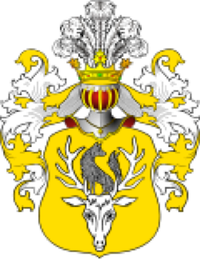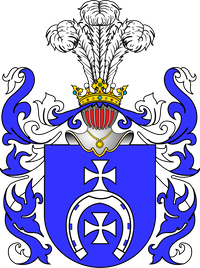__________________________________________________________________________________________________________
DNA studies of Radzimski / Radziemski’s origin.
Genetic genealogy is currently becoming the most effective method to recognize our origin both in the ethnic sense, as well as to establish connections between individual branches of a given family. In an inexpensive way, one can learn about the true origin of ancestors. One of the available methods is to study the Y chromosome, inherited in virtually unchanged form only in the male line, i.e. from father to son. The simplest Y chromosome test analyzing 12 markers allows the determination of the so-called haplogroup, i.e. a genetic group characteristic of a given population and area (Germans, Slavs, Jews, etc.). Nearly 60% of the Polish population belongs to the haplogroup R1a, whose members are associated with the Polans, Pomeranian, Balts, Scythian, Carpathian or Viking populations. This group was formed around 20-22 thousand years ago. The Radzimski families belongs to the R1a haplogroup. A more detailed analysis of the Y chromosome helps identify individual subgroups or branches of the family tree. From the analysis of markers collected by various people with the surname Radzimski or Radziemski, inluding authors of this short summary, two separate branches have been identified so far: YP237 called the South Baltic, and R-L260 called the West Slavic branch. This effort was part of the project “Urzecze”, that is managed by Dr. M. Stanaszek from National Museum of Archeology in Warsaw, Poland. The formation of these two groups had to take place before the XIV/XV century, when surnames with the ending –ski were introduced in Poland. In most of the cases. these new names referred to the residence of the persons taking the given name. It was Radzim in case of Radzimski’s surname. Having Radzimski’s ancestors in two different branches, indicates that there were two places called Radzim in different regions of Poland, that gave origin to two different Radzimski’s families. According to the "Geographical Dictionary of the Duchy of Poland and other Slavic countries" from 1884, we can find at least ten places called Radzim or similar, such as, for example, Radzimie, Radzimia or Radzimin. When looking for ancestors initiating the YP237 and R-L260 branches, one had to find places with this name, one with northern connection and second predominantly with the slavic part. In addition, these places should belong to wealthy families most likely owing rights to bear coat of arms. According to the "Heraldry of Poland" by Kacper Niesiecki published in 1841, there were two lines of the Radzimski families in Poland, one bearing the coat of arms Napiwoń and the other coat of arms Lubicz.
The information about the Napiwoń coat of arms is available through various sources. The most detailed one is Polish Armorial of Kasper Niesiecki published in 1841. Here are some fragments: "The alleged ancestor of the Radzimski family is Fryczko Borek of the Napiwoń coat of arms, the Greater Poland general, who received from King Łokietek the city of Gostyń with 40 villages, including the city of Radzim, for his military assistance in the war with Knights of the Cross. … The grandson of General Borek, Maciej, inherited Pleszew, Raszków and Potarzyce with 12 villages, including Radzim, where he took residence. As a consequence he took Radzimski as his surname". This text places Maciej, ancestor of the Radzimski family, near Kalisz, i.e. the center of Poland. However, the ancestors of General Borek belonged to the great West Pomeranian Bork family, also called Borkonen or von Borcke (according to Georg Sello: Geschichtsquellen des burg - und schloßgesessenen Geschlechte von Borcke, Berlin 1898-1901). General Borek's ancestors settled in Poland probably around the 11th century. Therefore, it is this link that is responsible for the South-Baltic segment of the YP243 branch in this Radzimski’s part of the genealogy tree. Based on our initial research, we believe that Maciej selected Radzimia near Rychwal as his residence place.
As for the ancestor of the West Slavic branch R-L260, one should probably look for it among the families bearing the Lubicz coat of arms. Unfortunately, Niesiecki’s armoral contains only few details on this subject. A very extensive list of families using this coat of arms was created by Tadeusz Gajl in his armorial "Polish Noble Houses and their coats of arms" published in 1999. His list contains 1246 names, among them Radzimski and Radziminski. According to the author, the Lubicz coat of arms was established around 1190. The Lubicz coat of arms was the most widespread in the Brest, Lublin, Łęczyca, Poznań, Sandomierz, Kraków and Sieradz lands. This area is very extensive and so far it has not been possible to identify a specific person/family who would take the surname Radzimski from a place called Radzim and as a consequense link it with the R-L260 branch.
Analysis of historical texts indicates several candidates:
1. Radzimiński (Radzimski, Radziemski) from Radzimie in the province Kuyavian-Pomeranian Voivodeship, Sępólno, the commune of Kamień Krajeński. Radzim was mentioned in 1356.
2. Radzimińscy from Radzymin, commune of Regimin in Ciechanów county,
3. Radziminscy from Radzimin near Kcynia in Szubin county.
In summary, new opportunities for genealogical research based on Y chromosome permits identification the appropriate genetic and genealogical branch and thus deepen our knowledge about family relationships. Tests that for this purpose have become become very economical and easy to do. We encourage all genealogy enthusiasts, and especially visitors to this site, to do this test and inform us of the results. This will help all of us to obtain a greated understanding of our mutual linkages.
ZR & LJR

